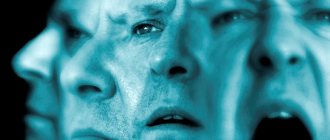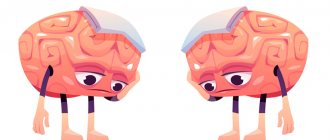Schizophrenia is a chronic disease that progresses from attack to attack or occurs continuously. Schizophrenia is characterized by a combination of ideas that do not correspond to reality (persecution, poisoning, exposure to “aliens” or “witchcraft”) and hallucinations (“voices”, “visions”). Sometimes the disease hardly manifests itself outwardly, but the person gradually becomes unemotional, callous, and loses interest in everything, even in his beloved activities and hobbies.
An experienced psychiatrist diagnoses and treats patients with schizophrenia.
How do you know if you have schizophrenia? In addition to talking with a psychiatrist, there are laboratory diagnostic methods - for example, Neurotest. It helps the doctor confirm the diagnosis and show the severity of schizophrenia. What symptoms and signs can be identified in an adult?
Modern diagnostics
We have prepared detailed information on each method - with scientific justification, description of research and cost (special offers are available).
A sharp change in interests - a passion for psychology, philosophy, a deep interest in religion in a previously unbelieving person, an awareness of the uselessness of friends and parents, the meaninglessness of life. These are some of the first signs of progressive schizophrenia.
Another group of symptoms are “voices in the head” that comment on actions, give orders or control thoughts, as well as ideas of persecution, poisoning, special treatment (everyone is watching the person, talking about him, laughing).
Important
Schizophrenia is one of the most complex and controversial mental illnesses. It can be similar to neurosis, depression, and even sometimes dementia.
The prognosis for schizophrenia is often unfavorable due to the frivolous attitude of the patients themselves to the disease. Medicines must be taken continuously and not stopped without the doctor’s knowledge, even if all symptoms have disappeared. With modern diagnostic and treatment methods, it is possible to achieve stable remission, maintain a job and live a full life.
General concept
Schizophrenia is a polymorphic disorder characterized by a gradual breakdown of thought processes and emotional reactions. It is one of the most common mental pathologies in modern society, which is progressive in nature. The patient loses normal mental functions: the process of healthy thinking is disrupted, which is accompanied by a gradual decrease in psychological activity.
The systematic development of mental pathology leads to volitional exhaustion, which ends in permanent disability. A schizophrenic is unable to continue active life while in a previously familiar society. Therefore, it is extremely important to detect the problem at the stage of its debut and carry out appropriate therapy that will help stop the disease, minimize its symptoms, and return a healthy, completely adequate person to society.
Types of mental deviation, their features
The schizophrenic process in women can occur in different forms: simple, resistant, paranoid, catatonic, and less commonly, hebephrenic. Each of them has its own characteristics, depending on which the following types are distinguished:
- continuously flowing. Attacks occur regularly and are characterized by varying duration and severity;
- episodic (paroxysmal). This form differs in that the patient may acutely feel only one or several attacks throughout the entire period of the disease. A timely response and regular monitoring by the patient of her condition preserves the effect after therapy for the longest possible time;
- unfavorable. Its peculiarity lies in the high speed of the progressive schizophrenic process. The final mental disorder can occur in the shortest possible period of time;
- sluggish. It is one of the most common forms of mental deviation among the fairer sex, which needs a more detailed description.
Sluggish schizophrenia
One of the most pronounced symptoms of this type of endogenous disease is the woman’s unusual behavior. In this case, one or more additional symptoms may be observed:
- delusional states, which are characterized by a distorted perception of reality - the patient becomes obsessed with persecutors, insists on her “superpowers” or the presence of an incurable disease;
- hallucinations. This is a manifestation of the disease in the form of non-existent voices that only a schizophrenic hears, as well as visions and smells;
- A frequent symptom is a tendency to philosophize. “Inside out” logic in such a patient is capable of creating the most incredible causal and hereditary relationships that have nothing to do with reality. In everything that happens, she begins to see omens, signs or symbols of approaching inevitability;
- loss of self-control. A schizophrenic woman is fully confident that in difficult or unforeseen situations she is unable to control her emotions, movements, speech, and someone does this for her (an otherworldly force, an ill-wisher, a relative);
- increased irritability is activated. Aggression manifests itself in the form of obvious hostility and asociality;
- the person loses interest in everything she previously did, becomes emotionless and withdrawn, and may not go outside for days;
- chronic depression, which is based on the inability to receive emotional pleasure;
- phobias and obsession. Suddenly you feel fear for your life, the life of your children or close relatives.
Ignoring the first signs of female schizophrenia provokes their further development and worsening. As a result, the patient experiences a total flattening of personality: mental sensitivity disappears, the level of social development decreases to primitive.
Symptoms and signs
At the initial stage, schizophrenia is often clinically similar to psychosis and anxiety disorders.
Therefore, when making a diagnosis, the pathogenesis and symptoms are carefully studied. Social and behavioral disorders appear as mental illness progresses. A woman from the outside may seem too conflicted, or, conversely, withdrawn. Gradually there is a distance from the family, and a severance of all social contacts.
Psychiatrists have combined the signs of schizophrenia into separate symptom complexes:
- Productive – delusions and hallucinatory symptoms are present;
- Negative – depression, apathy, lack of will;
- Impaired mental performance - decreased attention and perception, disorder of thought processes.
If there are productive symptoms, a woman becomes dangerous not only to herself, but also to others. Delusional symptoms often lead to suicide or severe injury to a person who happens to be nearby.
Schizophrenia is characterized by mannerisms in gestures and facial expressions. Postures become unnatural (frozen posture, lack of plasticity). But there are cases when, on the contrary, hypermotor agitation is noted.
Schizophrenia has similar symptoms to many mental disorders. Therefore, a single clinical symptom does not indicate schizophrenia.
The symptom complex in schizophrenia lasts at least a month. But all the signs appear against the backdrop of a deterioration in overall functionality in various areas of life, which lasts for six months.
Schizophrenia is a slowly progressive mental illness. Therefore, symptoms increase gradually. Each stage of the disease has its own characteristic signs. But there is a so-called prodrome of the disease, which lasts 2.5 years before the appearance of clear clinical signs. The woman becomes withdrawn, gradually moving away from family and friends. Emotional coldness and mood swings appear.
| Disease stage | Clinical picture |
| I – mental destabilization | Weak manifestations – obsessions, behavioral disorders, emotional coldness, panic attacks, “unhealthy” desire for cleanliness and order. Symptoms begin to increase as the disease progresses. Various hallucinations are added - auditory, visual, olfactory, tactile. Over time, a woman becomes socially maladapted. Primary signs are quite specific and do not always manifest themselves in a clear clinical picture. The intensity of symptoms also depends on the form of schizophrenia and the rate of progression of the pathology. |
| II – somatoform disorders | Hallucinatory symptoms increase. Against the background of a visual illusion of perception, tactile sensations appear. That is, the patient “obviously” feels her hallucination - insects crawling under the skin or in the internal organs, a feeling of rotting organs. Any information received is associated with some past event in life - each time a new cycle of hallucinations is formed. With sluggish schizophrenia, the patient’s behavior is difficult to predict. Mostly complaints about “terrible” appearance. With a mild form of the disease, patients are completely “disconnected” from reality. They have their own fictional world in which they feel comfortable being. There are catatonic symptoms and a desire to imitate. |
| III – productive symptoms | The woman becomes aggressive. Outbursts of rage arise from any irritant or against the background of hallucinosis. Hallucinations provoke delusional symptoms. Patients claim that they perform all actions according to orders - a voice in their head. It is impossible to predict behavior because “voices” begin to control a person. Such patients become socially dangerous. |
Without timely treatment, schizophrenia inevitably leads to irreversible changes in personality.
Many scientists are inclined to believe that the manifestation of the disease begins in adolescence. But the latent period of the disease can last for many years. Active symptoms may appear in women during the postpartum period. The body and central nervous system are under severe stress. Even for mentally healthy women, childbirth and motherhood are stressful. Therefore, if the psyche cannot cope with the load, then no woman can be immune from the development of schizophrenia.
Mood swings and behavioral disorders occur in women even during the period of declining sexual function. Menopausal syndrome provokes neurovegetative, psychoemotional and metabolic changes. According to WHO, the number of patients who develop mental disorders due to estrogen deficiency increases every year.
But there are also factors that can trigger schizophrenia even in old age. These factors were designated as psychosocial. Internal and external changes in a woman (aging) require the body to activate adaptation mechanisms. But this doesn't always happen.
Late manifestation of the disease (55–60 years) has an atypical course. Therefore, it is more often called paraphrenia. In this case, hallucinatory-delusional psychoses do not have a pronounced destructive effect on the personality. Paraphrenia has its own ICD code. It is considered as a separate diagnostic category.
Scientists have come to the conclusion that the manifestation of the disease at a later age (after 45 years) is more common in women who are prosperous and have realized themselves in all areas of life. They had negative symptoms, but disorganization was only slightly expressed. Paranoia and hallucinatory symptoms are pronounced.
Age gradation was applied to schizophrenia. Thus, it was divided into subtypes, but only for convenience. Because the clinical features are not different.
Subtypes:
- Late-onset disease – from 40 to 60 years;
- A very late-onset disease - from 60 years of age (schizophrenia-like psychoses).
Late schizophrenia also occurs in various forms and has a different prognosis for life.
General symptoms
An endogenous disease such as schizophrenia does not occur suddenly. As a rule, its obvious manifestation is preceded by months, or even years, when the symptoms were practically invisible to others. During this period, a woman gradually withdraws from society, breaks off previous social ties, and withdraws into herself.
A gradual change may not be noticed in a timely manner even by the closest people, which contributes to the worsening of the condition until the moment when obvious signs of mental disorder begin to appear. During the onset of the disease, people around you often mistake such hidden manifestations for depression or an affective disorder.
The main symptoms and signs of female schizophrenia are:
- feeling of isolation, inability to take initiative, gradual decrease in mental activity;
- abnormal perceptions of what is happening;
- deviating statements, conclusions and judgments;
- speech disorders that arise as a result of mental flattening;
- limited emotional expressions;
- low volitional and motivational activity;
- worsening memory and performance functions;
- behavior that is incomprehensible to other people;
- violations in the field of movement coordination and control systems.
The onset of schizophrenia is accompanied by persistent feelings of tension, depression or depression. A woman experiences a sudden lack of attention and fatigue, which provokes a feeling of physical and psychological overload.
A schizophrenic does not come out of a pessimistic state for a long time, which gets worse over time. Paranoid factors begin to actively influence his perception of the world: he begins to feel that something extremely important is happening around him, but cannot understand what exactly. Demanding an explanation from others, a woman thus turns on the protective function of the body: “Pay attention to me,” “Tell me what’s wrong with me.”
The patient gradually breaks the connection between herself and the previous, threatening, in her opinion, reality, and creates for herself a new variation of it. In a new, painful perception for her, everything around her takes on an enemy form: people who wish her harm, events that are specially arranged, not real, created artificially in order to lull her vigilance.
An ordinary trip around the city, organized by a husband or friend, can be perceived as a theatrical act to distract her from something more significant. The media turn into primary enemies, which, exerting a hypnotic influence on her, deliberately mislead her.
The life of a schizophrenic turns into constant waiting and following higher signs. This especially applies to women with a family: they begin to devote their lives to constant monitoring of relatives and loved ones (children, husband), sincerely believing that they are protecting them and themselves from negative influence from the outside.
Insomnia – a symptom or a temporary physiological feature?
In some cases, sleep disturbance actually occurs due to nervous exhaustion and prolonged overexertion. However, if insomnia is accompanied by at least one of the above-mentioned signs of the schizophrenic process (constant tension, mistrust, excessive suspiciousness), this is a reason to seek advice from a specialist.
The patient feels constant anxiety and fears, which gradually transform into phobias. As a result of this, sleep and wakefulness are disrupted: the person, being in a state of constant fear and inability to give a correct assessment of what is happening, begins to be afraid to sleep. A ban on proper rest is formed in the subconscious, and the schizotypal personality gradually brings himself into a state of physical exhaustion, which only aggravates the general condition.
Colored dreams: what do they indicate?
According to one theory, the colored dreams that a representative of the weaker half of humanity can see are a clear sign of the beginning of the development of the schizophrenic process. However, experts in the field of psychiatry consider this to be a misconception. Such dreams only indicate a person’s subtle perception of the surrounding reality. Women are more capable of empathetic sensitivity than men. This explains their increased vulnerability and susceptibility.
Thus, it is incorrect to talk about a direct connection between color dreams and schizophrenia. But increased sensitivity in women in the case of a negative atmosphere in the family can become a trigger for the onset of the development of a mental disorder.
Causes of the disease
Schizophrenia begins to develop as a result of a disturbance in the exchange of neurotransmitters - signaling molecules that ensure interaction between brain cells.
Despite the fact that the disease can be inherited, it is not always associated with this factor. Of all the reasons that can act as a trigger for the onset of the development of an endogenous disease of a schizophrenic nature in women, the most active can be identified:
- unfavorable intrauterine development or hereditary aspects. Genetic mutations can occur spontaneously - during pregnancy or after the birth of a child. They can remain in a “sleeping” state for a long time. Genetic predisposition is also important, when one of the blood relatives had a similar disease;
- violations of the educational process. Permissiveness and promiscuity of a teenage girl due to the ambiguity of the parent/parents can lead to severe mental disorders. And also, according to medical statistics, cases of schizophrenia, which occurs as a result of insufficient maternal attention to the child during the formation of his psyche, have become more frequent;
- shock and stress factors. In most cases, they are the trigger mechanism for those mental processes that occurred sluggishly in a woman’s body and did not manifest themselves for a long period;
- age crises. The first of these occurs when a girl leaves parental care and begins to form her own separate, independent life. In the future, due to the characteristics of the female body, she experiences many additional stress factors - hormonal teenage changes, pregnancy, childbirth, postpartum psychosis, menopause. Especially often, signs of schizophrenia are observed in those individuals who are in the involution phase - the disappearance of menstrual function, a sharp decrease in hormone production. A qualified specialist will always be able to distinguish a psychoaffective disorder associated with age-related changes from a pathology of a schizophrenic nature;
- regular intoxication with alcohol and drugs.
One interesting case is described in the medical literature when a schizophrenic woman herself turned to a psychotherapist for help. After the birth of her child, a 27-year-old woman began to feel extremely uncomfortable: she began to feel as if her baby’s life was in danger, but she could not specifically explain what exactly was bothering her. Not finding support in her family, she turned to magic: having read on the Internet about different ways and methods to protect a child, she tried to put them into practice.
The husband did not pay attention to this in a timely manner, mistaking the young mother’s inappropriate behavior for postpartum psychosis. But gradually the situation worsened: the woman began to devote a lot of time to “cleansing karma,” so the child often remained hungry and unkempt. In response to all the husband’s comments, the wife replied that she was doing a more important thing - she was saving their family.
The woman completely refused to communicate with her parents, because in her visions they are the ones who bring trouble by trying to harm their grandson. At moments she had an epiphany: she told her husband that she did not understand what was happening to her, and asked for help. Not receiving support, she returned to her previous occult activities. Only now her phobia has worsened: she has already “saved” not only the child, but also her husband, who, she is convinced, has a mistress. Gradually, the woman cut off all her previous contacts and connections, believing that all her friends were traitors and were secretly laughing at her.
The young mother became extremely suspicious and antisocial: she did not go outside for days. In response to her husband’s remark that the child needed to go for a walk, she made up non-existent myths about a new viral disease. Gradually, she stopped taking care of her appearance, became unkempt, and considered all hygiene procedures to be just a formality. Intimate relationships between the spouses completely ceased.
After the next ritual, the woman forgot to blow out the candles and fell asleep. As a result of the fire, which was quickly extinguished, her baby ended up in the hospital. Realizing that she was the one who harmed him, she went to see a psychiatrist.
After establishing a diagnosis of episodic paranoid schizophrenia, the doctor prescribed appropriate therapy. To begin with, he had a conversation with the patient’s husband, to whom he explained all the features of his wife’s illness, and the rules of behavior with her. Due to the lack of need for hospital treatment, the patient was prescribed special medications. Their dosage, depending on the patient’s condition, was regularly administered by the attending physician.
As a result of the persistent joint work of the specialist, the patient and her immediate environment, the patient began to feel much better after 4 months and fully realized the error of her phobia. Now this made her perplexed: “Did all this really happen to me?” The husband became more attentive to his wife and began to devote more time to her and the child. She periodically visits a psychotherapist in order to prevent a recurrence of the disease.
How to determine if another person has schizophrenia?
Do you know how to identify a schizophrenic by their behavior ? Let's take a closer look at this issue:
An apathetic attitude towards the world around us arises. The first sign may be concern. Anxiety can arise without good reason. All a person’s thoughts are occupied only with her, which is why insomnia often occurs. Anxiety can also be a cause of neurosis, so it is always recommended to contact an appropriate specialist.
Patients constantly talk about scientific topics that do not correspond to their level of intelligence. They may lose their thoughts and are quite difficult to understand, which is the first sign of schizophrenia.
How can you tell if a person has schizophrenia ? To make a diagnosis, it is necessary to take into account various factors such as the period of pregnancy by the mother, the development of the child, stressful situations, and so on.
Secondary methods include:
- Pathopsychological examination by a psychologist at a clinical center,
- Examination within a laboratory institution,
- Neurotest and Neurophysiological test system.










